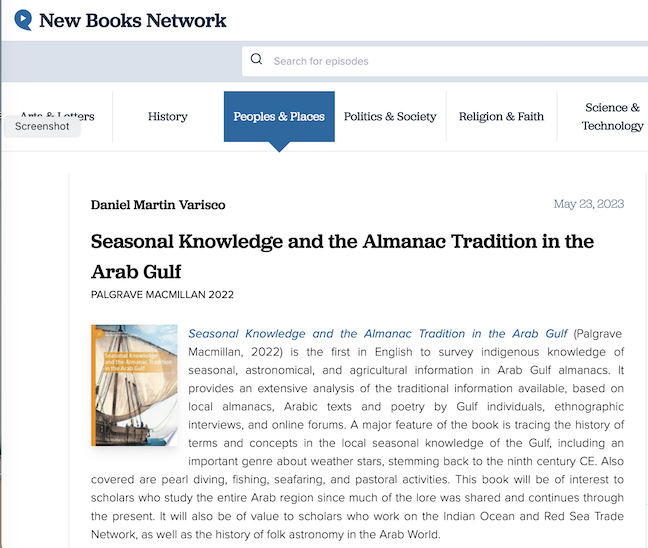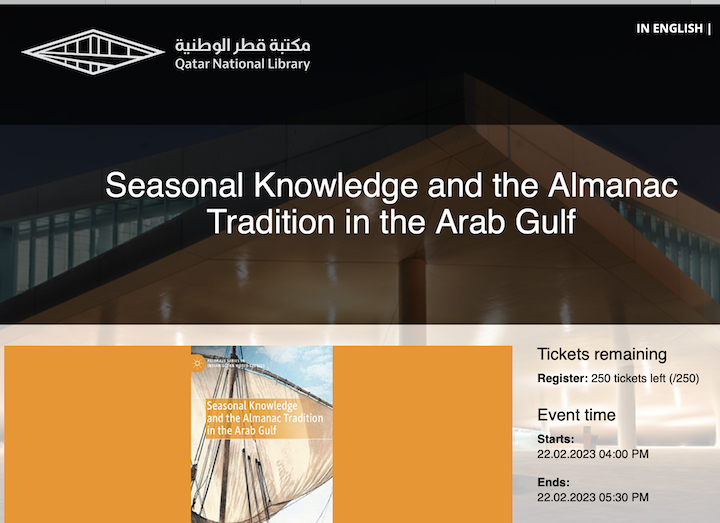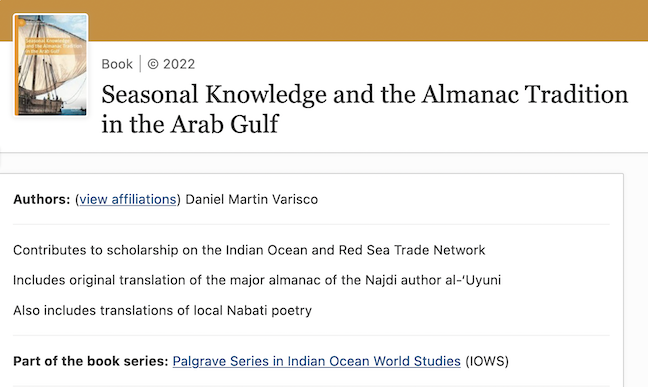
My podcast with Ahmed AlMaazmi and Tamara Fernando is posted online on the New Books Network.

My podcast with Ahmed AlMaazmi and Tamara Fernando is posted online on the New Books Network.
I will be giving a book launch on my recent book on Gulf almanac lore via Zoom for the Qatar National Library on February 22, 2023. Details about registering for the talk are provided at https://events.qnl.qa/event/opOp5/EN. Please feel free to spread word of the talk. Details on the book are at:https://link.springer.com/book/10.1007/978-3-030-95771-1.

I am pleased to announce the publication of my new book: Seasonal Knowledge and the Almanac Tradition of the Arab Gulf. Details about the book, including a free online pdf of the table of contents can be obtained here: https://link.springer.com/book/10.1007/978-3-030-95771-1

Below is the start of the Introduction…
Before the middle of the twentieth century, everyday life in the Arab Gulf was oriented to the sea and the land. Along the coast and for the island of Bahrain there had been a thriving pearl diving industry until the 1920s, while fishing remained one of the most important food production activities. Trade around and beyond the peninsula was still largely carried out by traditional dhows. Apart from Oman, which has a long tradition of irrigated and rainfed agriculture, most of the Gulf states faced a harsh, arid environment with limited water and only a few fertile oases. Herding of camels, sheep and goat was one of the main ways of surviving in the arid areas. It should not be surprising that prior to the oil wealth that created a lush economic transformation, the main topic of concern was the weather. Successful navigation, pearl diving and fishing required an intimate knowledge of seasonal change, as did pastoralism and farming.
Information on the seasonal sequence for the Arabian Peninsula stems back over a thousand years in collections of poetry, star lore and almanacs. One of the most important Arabic texts is the Kit?b al-Anw?’ (Book of Weather Stars) of Ibn Qutayba (d. 276/879), who is quoted by almanac compilers in the Gulf to this day. Ibn Qutayba describes in detail local knowledge about star risings and settings, weather seasons, pastoral activities, agriculture and a range of environmental conditions. Unfortunately, much of this indigenous heritage has disappeared, as the folklore of generations is now rarely passed on orally within families. In recent years older individuals in the Gulf have written memoirs, preserving their knowledge of life before the Petro Utopia. This gives us a glimpse of the past, a puzzle with many missing pieces, but not the full understanding that comes with actual contact.Resurrecting the history of seasonal knowledge in the Arab Gulf and the entire Arabian Peninsula thus requires a textual archaeology. It is not enough to simply document what is written, as though one is showing off museum objects; this knowledge needs to be placed into a lived context to have a better understanding of how people went about their lives off the land and on the sea.
The past is like an ocean in which we can sample only a small part of the vast number of ideas and customs that have passed by over the years. To follow this metaphor, most of our sampling is along the shore, learning from individuals we can ask directly or engage with in ethnographic fieldwork. We can only cast our research net a short distance in trying to reach back into what really happened and was said in the past. A historian can sail as well, dropping an anchor where there seems to be something worth exploring. But there are depths in this ocean of knowledge that can never be reached. There are also reefs, barriers that make it difficult to have smooth sailing through our disciplined search for the past. To what extent can we know what local knowledge was shared? Then there is the question of what kind of fish we are trying to catch. Is everything that has been done and said, no matter how many generations back, something we should call “heritage”? If we read about it in a book, even one written centuries ago, does that automatically make it “heritage”? How can we vouch for the accuracy of what has been written down when we cannot see it for ourselves or question the interpreter? These are not insurmountable hurdles, but they do caution us to recognize the limitations of reconstructing the past.
My career as a scholar began in the highland mountains of Yemen, where I carried out ethnographic research on traditional water resource use and local agriculture in the late 1970s. Talking with farmers and observing their work for over a year allowed me to gain an understanding of local practices that no book could give me. While in the field I had access to a fourteenth century Yemeni agricultural text, which described many of the agricultural activities I was seeing for myself. My first book was an edition and translation of a thirteenth century Yemeni agricultural almanac. Over the years I have become what is best called a historical anthropologist, someone who looks at heritage as a product evolving from a past and not simply what one sees, without hindsight, functioning in the present. As an anthropologist I focus on the diversity of what people do and say, giving voice to them rather than plugging them into an outside theoretical package from the start. As a historian I have an opportunity in examining texts to see the strands of past knowledge that survive and still influence the present.

Read the article here.

By El-Sayed el-Aswad
This article relates to a previous paper entitled “Egyptian Cosmology and the Grand Canyon” published by Tabsir on September 1, 2007. I revisited the Grand Canyon in October this year (2021) to have a closer look that might help with rethinking earlier views. In this present thesis I aspire to shed more light on the obfuscated issue of ancient Egyptians and other past people who are thought by several explorers to have impacted the Grand Canyon and other places in the North America prior to the arrival of Columbus. In fact, there has been ongoing debate since the appearance of a front-page story of the Arizona Gazette on April 5, 1909 reporting on an archeological expedition of the Grand Canyon in which an underground network of tunnels, caves and cities was found above the Colorado River, containing various oriental and ancient Egyptian artifacts, statues, hieroglyphs, and mummies, among other items. The report in the Arizona Gazette relied on the findings of G. E. Kinkaid and Professor David Jordan (McEwen, 2000; Reyes, 2019). It is interesting to note that, preceding them, John Wesley Powell, an American geologist and the first director of the Smithsonian’s Bureau of Ethnology, made several expeditions funded by the government, to the area in 1868 and 1871-1872, and proposed the name of the “Grand Canyon” instead of the previous name, the “Big Canyon.” Powell and other explorers coined historically and mythically inspired names of temples and towers including those of Isis, Osiris, Horus, Ra, Set, Cheops Pyramid, and Shiva, for example (Carpenter, 2020) for some of the outstanding and poignant geographical features/sites in the Canyon.
The following points highlight the controversial aspects or pros and cons concerning the findings of Kinkaid reported by Arizona Gazette.
1- The Smithsonian Institute, motivated by conspiracy theories, rejected both the findings of Kinkaid and the Gazette’s report.
2- The Smithsonian Institute described the report of the Arizona Gazette as a hoax aimed at gaining publicity and selling more copies.
3- The Smithsonian’s Department of Anthropology denied hiring Kincaid and Professor Jordan for conducting any research. It also denied any records verifying the existence of Kincaid or Professor Jordan (Carpenter, 2020).
4- Government institutions have been involved in protecting what they consider a forbidden zone encompassing secret caves and sensitive areas in the Grand Canyon, even guarding them with armed forces. People have not been allowed to approach these caves. This forbidden zone contains Egyptian and oriental monikers as well as ancient manmade chambers (Carpenter, 2020).
5- Those who support the findings of both Kinkaid and the Arizona Gazette’s report argue that the Smithsonian Institute intended to cover up archeological discoveries in order to preserve the current view that there was no transoceanic contact in pre-Columbian time (Eisten, 1999) and that the ancient Egyptians never ventured outside of the river Nile (CNY Artifact Recovery, 2013).
6- Several authors have indicated that the Smithsonian, in its rejection of the historical findings, referred to the Phoenix Gazette rather than the Arizona Gazette, which might be considered an error, but might also be viewed as a cover-up (CNY Artifact Recovery, 2013; McEwen 2000).
7- The government has been criticized for its role in covering up historical and archeological discoveries that oppose traditional academic teachings (Carpenter, 2020). As Don Lago (2009) put it, when the Smithsonian and the government deny the reality of the Egyptian cave, they are denying the existence of the spiritual world; they become symbols of the secular worldview.
8- Supporters of the findings of Kincaid and Jordan state that Professor D. S. Jordan, who served as President of Indiana University (1885-1891), and as President and then Chancellor of Stanford University (1892-1916), was affiliated with the Smithsonian for a 30-year period (1880-1910), when he was offered a top job at the Smithsonian in 1906. In 1898, Jordan made an expedition down the Grand Canyon. He, accompanied by T. Kincaid, also made an expedition to Alaska. He is also prominently found in many Smithsonian publications from the 1800s (Newswire, 2014). In a word, despite their denial of any association with him, Professor Jordan’s photo can be found within the Smithsonian Archives (See, Accession 90-105, Science Service Records, Image No. SIA2008-4524: https://collections.si.edu/search/detail/edanmdm:siris_arc_397686?q=Professor+David+Starr+Jordan&fq=online_media_type%3A%22Images%22&record=14&hlterm=Professor%2BDavid%2BStarr%2BJordan&inline=true)
9- Despite the denial of the existence of Egyptian caves, there are caves named after the explorers of Kincaid and Powell (Reyes, 2019). Forensic geologist, Scott Wolter (2014), funded by the History Channel, produced a video documenting caves and other sites in the Grand Canyon pertaining to Egyptian treasures discovered in the Grand Canyon.
10- In conclusion, there is an urgent need to objectively rethink historical and archeological discoveries in the Grand Canyon and elsewhere without disturbing cultural and historical chains.

References
Carpenter, Mark A. (2020, 1 November). Forbidden Zone of The Grand Canyon: Legends, Landmarks & Lies. Ancient Origins: 17-51. Retrieved from https://www.ancient-origins.net/ancient-places-americas/grand-canyon-forbidden-zone-0014481
CNY Artifact Recovery (2013, Dec. 29). Egyptian Treasure in the Grand Canyon. Retrieved from https://cnyartifactrecovery.wordpress.com/tag/phoenix-gazette/
Lago, Don. (2009). The Origins of the Grand Canyon Egyptian Cave Myth. Grand Canyon Historical Society, 20(2), 2-11. Retrieved from http://grandcanyonhistory.org/uploads/3/4/4/2/34422134/top_2009_2.pdf
McEwen, Barry (2000, December 1). Ancient Egyptian treasures in the Grand Canyon: Suppressed archeological information and metaphysical paradox? TETRA-MATRIX@prodigy.net (McEwen). Retrieved from https://www.cyberspaceorbit.com/text/0000tx09x.html
Newswire. (2014, Sept. 12). Smithsonian’s Enigmatic Prof. Jordan, Linked to 1909 Arizona Newspaper Article, Identified. Retrieved from https://www.newswire.com/news/smithsonians-enigmatic-prof-jordan-linked-to-1909-arizona
Reyes, Anita (2019, July 19). Legend of Egyptian Artifacts in the Grand Canyon. See The Southwest. Retrieved from https://seethesouthwest.com/the-legend-of-the-egyptian-artifacts/
Wolter, Scott (2014). American Unearthed: Egyptian Treasure Discovered in the Grand Canyon (S2 E5) | Full Episode. Channel History, YouTube Video #39 https://www.youtube.com/watch?v=uPBgFAETrF4&ab_channel=HISTORY ?

The online event “Under the Sails – Maritime Conversation on Trade and Seafaring. Perspectives from Iran and Kuwait” held on May 26, 2021 is now available to view on Youtube. This is a fascinating set of interviews with both Kuwaiti and Iranian ship captains of the past. It is well worth watching.